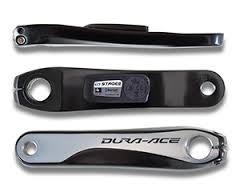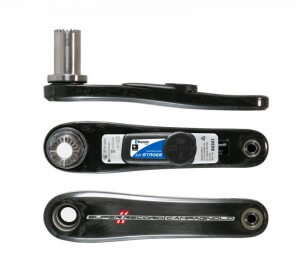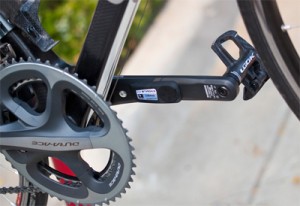 Power Meter Type: Strain gauge w/accelerometer cadence. Crank mounted.
Power Meter Type: Strain gauge w/accelerometer cadence. Crank mounted.
Point of Origin: Assembled in United States of America
U.S. Service Center: Yes. Colorado.
Web Site: www.stagescycling.com or click here to place a Stages order online.
Overview: When Stages Cycling first entered the power meter market in ’11/’12, they may have been a new name to most cyclists, but they were not new to power measurement. Having built spin bikes with integrated power measurement for many years, Stages Cycling was in an excellent position to bring a proven track record into the outdoor power meter market. Stages Cycling offers a strain gauge based minimalist power meter solution. The Stages Power meter is simply a strain gauge integrated with a non-driveside crank arm. The system is simple, very light (20 grams) and works with any ANT+ or Bluetooth Smart protocol capable computer or phone.
The Stages Cycling power meter really uses modern technology applications to its advantage to keep things simple and affordable. The Stages was one of the first units to even eliminate the cadence magnet as the unit uses an application that senses the location/angle of the power meter with an accelerometer and thus counts cadence without a magnet. Being Bluetooth Smart enabled, firmware updates can be done wirelessly through a smart phone or iPad. The unit is very unobtrusive and simple, thus minimizing cost; left crankarms, including the integrated power meter, start around $500 and complete cranksets with integrated power meter are also available.
When it comes to serviceability of the Stages Cycling power meter, there isn’t much to service. Batteries are easily replaced by the consumer and the system automatically senses temperature and compensates its measurements in that regard. This temperature compensation was refined greatly in firmware updates in the spring of 2013 and the Stages is now one of the most consistent power meters (least affected) across temperature fluctuations due to elevation change or just atmospheric changes. This is a place where Stages was a leader in the power meter field as many power meters before 2014 would experience fluctuations due to temperature that could cause data to roam markedly unless careful calibration was done before each ride.
Accuracy of the Stages Power Meter is rated at +/-2% and we have found that Stages units are accurate within their stated range relative to themselves. What we mean by this is that if you are using another brand of power meter simultaneously, you are likely going to see variance between the units. However, you won’t see variance in the data coming from the Stages Powe r Meter compared to itself day in and day out. Internal testing by our staff and external testing by clients indicate that much of the variation in power data between manufacturers is due to where the power meter measures power- left crank (Stages), right spider (Quarq & SRM), left and right cranks (Infocrank), pedals (Garmin, PowerTap and Look), rear wheel (PowerTap) and chainring (PowerTap).
r Meter compared to itself day in and day out. Internal testing by our staff and external testing by clients indicate that much of the variation in power data between manufacturers is due to where the power meter measures power- left crank (Stages), right spider (Quarq & SRM), left and right cranks (Infocrank), pedals (Garmin, PowerTap and Look), rear wheel (PowerTap) and chainring (PowerTap).
A single sided power meter design, like a Stages, reads just off the left crankarm and do a calculation to determine average power (basically doubling the reading). Meanwhile, a spider mounted power meter, like a Quarq, reads more off the BB spindle and a dual sided pedal mounted system (like the Garmin Vector 2 and PowerTap Power Pedal) detects power from both sides. This means that if a rider has a left or right leg dominance, the single sided units will read higher or lower than the BB and dual sided units because it assumes equal power coming from both legs. For many riders, they mainly want to know their sustainable relative power and a Stages will work great for these riders. However, for those that really want to analyze left/right power, they should look at some of the more advanced  units from Quarq, PowerTap and Garmin. And, if you really want to dive into the details of all the potential cycling dynamics of your pedal stroke, you really need a unit that measures independently off each leg (Garmin Vector 2, Look Power Pedal…).
units from Quarq, PowerTap and Garmin. And, if you really want to dive into the details of all the potential cycling dynamics of your pedal stroke, you really need a unit that measures independently off each leg (Garmin Vector 2, Look Power Pedal…).
At the end of 2015, Stages Power Meters announced that they were releasing their first carbon fiber versions which would include power meters that worked with FSA, SRAM and Campagnolo. The Campagnolo Stages Power Meter was particularly big news as there were few power meter options that allowed you to continue to use a Campagnolo crank and available options from SRM were on the higher end of the price spectrum. Previously, Stages Cycling power meters were only available in alloy crankarm models as the nature of the strain gauge sensitivity had not progressed to the point where it could be affixed to a carbon crank and provide accurate data. Now, regardless of your component of choice, you no longer have to choose between aesthetics and using a Stages Power Meter.
The Stages Cycling power meter is a proven and high value power meter for anyone looking for the fundamentals of power measurement and who isn’t concerned about pedaling dynamics and left/right power analysis. Simple, light, modern and affordable are all hallmarks of a good design and this power meter offers all of these in spades.
Pros of a Stages Cycling Power Meter:
- Can be used with any wheelset without having to buy another power meter.
- No cadence magnet.
- U.S. Service Center that is well staffed and dedicated.
- With external bearing cranks, it is easier than ever to switch between bikes.
- Priced very well.
- User replaceable batteries.
- ANT+ and Bluetooth Smart compatibility means you can use most any head from Garmin, PowerTap and others as well as many popular phones/devices.
- Wireless firmware updates allow you to take advantage of improvements in technology without hardware alterations.
- Very light and minimalist design.
- Easy installation.
Considerations of a Stages Cycling Power Meters:
- Relative power is the focus of the Stages, not pedaling dynamics or left to right analysis as found in some pricier units.
- While completely accurate relative to itself, if you have a difference in power left to right, the Stages may read higher or lower than some other power meters for this reason.
- Battery cover could be sealed better. In-line battery housing and seal improvements have been made through the years, with a notable rolling refinement into 2016.
Accuracy: +/-2%. .
Reliability/Maintenance: After some of the usual teething issues with a new product (a weak battery seal and some initial firmware issues), the current Stages Cycling Power Meter units offer strong reliability and little maintenance. As with any power meter, we highly recommend installing the latest firmware regularly for the greatest stability, accuracy and feature range. Maintenance on a Stages Power Meter is minimal and changing the standard batteries is pretty easy and not required very frequently as battery life can reach 400 hours of use between changes. A refined housing and battery door were introduced at the end of ’15 and reinforced battery doors and seals are available for earlier units.
Compatibility/Limitations: A Stages Power Meter will work on most any frame that accepts one of the cranks that is offered. The only exception we have found are some bikes with under the chainstay mounted brakes (’14 Parlee TTiR, for example) won’t work with certain brake caliper models (Shimano), but will work with others.
As of 2016, Stages Cycling Power Meters will be available in Shimano, SRAM, Campagnolo, FSA and Cannondale versions in both alloy and carbon fiber. Previous to 2016, only alloy versions were available.
Display Quality/Features: Stages Cycling does not make computer heads. The Stages Power Meter is ANT+ and Bluetooth Smart compatible and you can use it with any compatible head of your choice from brands like Garmin and CycleOps as well as with smart devices like the iPhone and iPad.
Weight: The Stages Power Meter is one of the the lightest power meters on the market, adding only 20 grams to the regular crankarm weight.
L/R Power Balance: No. Part of the beauty of the Stages design is the simplicity. This simplicity has some limitations though.
Ease of Installation and Transfer between Bikes: If you can remove and install your current left crank arms, you can likely install a Stages Cycling Power Meter. Transferring between bikes is as easy as switching pedals if you have the same driveside crank model on both bikes.
Software/Hardware: Stages Cycling does not make software and none is included with the power meter. However, Training Peaks, Strava, Garmin Training Center and others are all compatible. Stages has a Bluetooth phone app for updating firmware and settings on their units that works well.
Conclusions: For the rider not concerned about detailed left/right analysis, the Stages system offers an established design that is simple, light, modern, affordable. As of the 2016 model year, Stages expanded their range of alloy cranks to also include carbon; the majority of popular cranks from Shimano, SRAM, FSA, Campagnolo and Cannondale are now available. Further improvements to the battery housing seem to have mitigated the seal issues a percentage of earlier Stages units experienced while a significant price drop at the end of 2015 makes the units more accessible than ever.
Call or email for more information on Stages or click here to order a Stages Power Meter!

